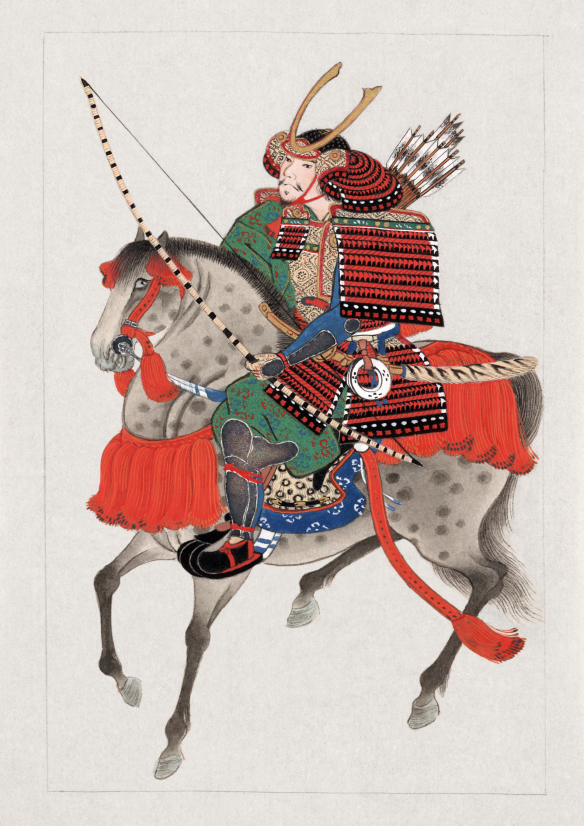Foreign powers, domestic lawbreakers, and personal enemies were not the only antagonists against whom early bushi and their institutional forebears directed their martial power. For not all adversaries of the state or the throne were human.
Under the ritsuryo polity and its antecedents, the Japanese emperor emerged as a sacerdotal monarch reigning over a liturgical community of noble houses. The operations of this liturgical community were conducted as much through the rituals and ceremonies that filled the court calendar as through the sorts of activities modern audiences conventionally associate with governance. To the Japanese of the Nara, Heian and Kamakura eras, ritual and ceremony were not quaint or meaningless customs designed to occupy the time of bored courtiers, they were a visible symbol of the social order and served an important function in vitalizing and renewing the polity. Thus it is an error to think of court politics as having become ceremonial during the Heian period (as textbooks and survey histories often contend), for, from the very beginning, court ritual and ceremony were politics.
As such, defense of the emperor and of the state involved more than just guarding the security of his corporeal body, and military service extended into the realm of magic and exorcism. Participation in rites of this sort was, in effect, an alternative type of military service, one equally valued at the time as police work and battlefield activity. In premodern societies, technology and magic were not separable phenomena. It should not be surprising, then, that the military arts, being just one more kind of technology, also had a magical function in premodern Japan.
In fact, magical and exorcistic military functions were considered important enough to warrant the creation of a guard unit specializing in them. The Takiguchi, formed in the late ninth century as a detail of bodyguards attached to Emperor Uda’s private secretariat, the Kurodo dokoro, was composed of men recruited for their martial skills, and yet there are virtually no sources that portray Takiguchi guardsmen engaged in ordinary personal defense or law-enforcement activities. Their main function seems, rather, to have been exorcism and divination.
Among their duties was a rite called meigen (“sighing bowstring”) or tsuru-uchi (“striking the bowstring”), which involved the drawing and releasing of bows without shooting arrows. This was performed at regular hours throughout the night, and on such occasions as births, illnesses, thunderclaps or other inauspicious omens, and – intriguingly – prior to an emperor’s entry to his bath. It was also performed by Takiguchi whenever they came on duty. This is the background to the scene in the Genji monogatari in which Genji, frightened by an apparition in a dream and by the Yugao lady’s sudden illness, summons a servant and orders him to
“Tell the escort to twang his bowstring and keep shouting.” . . . The servant, a member of the Takiguchi, could be heard twanging his bow with expert skill . . .. The sound reminded Genji of the imperial palace. The roll call would be over by now; the guardsmen were probably twanging their bows and proclaiming their names.
Rites such as meigen reflect a belief that the bow was more than just a prosaic weapon, that it was a magical instrument with the power to drive away evil spirits and disperse ghosts. The notion that weapons could be used to ward off evil and invite good fortune probably derives from Taoist practices, but it was thoroughly ingrained with native Japanese (Shinto) ideals by the start of the ritsuryo era. It was expressed at court not only in meigen exercises, but also in the numerous wrestling (sumai) and archery (jarai) ceremonies held throughout the year.
#
The proliferation of private warfaring that occurred over the course of the early medieval period was symptomatic of a fundamental change in Japanese definitions of Just War, one that centered on the replacement of courtier values with those of the bushi themselves. While the former focused narrowly on central government sanction, the latter broadly embraced the right of warriors to fight on the personal authority of courtier or bushi patrons, as well as in pursuit or defense of private profit or matters of honor.
The new ethic was nascent during the Heian period, but bushi remained politically constrained enough that they were obliged to bow to courtier rules and definitions governing their droit de guerre. The Gempei War (1180–85) unleashed widespread local violence conducted under the banner of public war, and the Kamakura shogunate that emerged from this fighting found itself unable fully to constrain small-scale private conflicts, because it depended for its existence as much on the backing of its own warrior vassals as on the credibility of its promises to the court to maintain law and order. The fourteenth century witnessed six decades of more or less constant civil war, fueled by two competing centers of political legitimation, which made it both possible to wrap almost any private fight in the banner of the larger public war and impossible for either government to restrain its warriors, lest they simply change allegiance to the other side. The result was the end of any meaningful distinctions between public and private warfare, and of the ability of governments to assert the primacy of centrally dictated law over warrior self-help. Henceforth, bushi notions of Just War would prevail.
